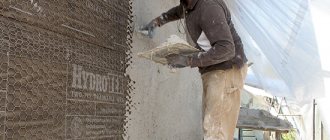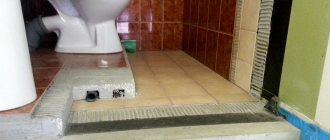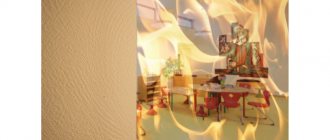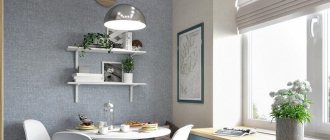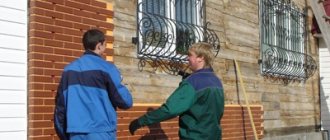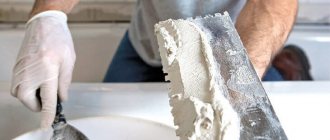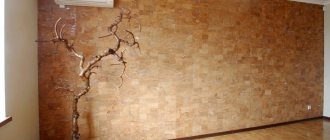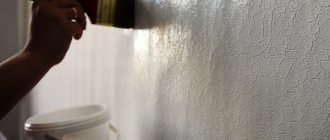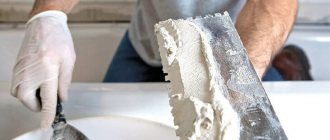Silence is a luxury for those who live in noisy areas of the city. This also applies to apartment owners in a panel building, where all sounds are heard very clearly and loudly. What to do in this case? How to reduce noise penetration into a room? One option is soundproofing under wallpaper. This is a simple and effective method to make a room quieter and more comfortable. It is noteworthy that such work should be carried out at the renovation stage, before wallpapering the walls. If everything is done correctly and the room is properly equipped, then living will be comfortable, and even quarreling neighbors will not be able to interfere with watching a movie or reading a book.
Sound insulation materials
There are several types, divided into performing specific functions.
Sound insulation – reflection of incoming noise. The sound insulation of a wall is determined by its thickness. The thicker the structure, the better the sound insulation. Noise insulation index 52-60 dB. Additional soundproofing materials include plasterboard.
Noise absorption - absorption of noise by the material used, which has a structure of fibers, with the addition of crumbs, looks like cells. Sound absorption coefficient 0-1. Average value 0.4.
Soundproofing materials include films and membranes. They are thin and at the same time have a good coefficient. The mineral membrane has a thickness of 0.25-0.37 cm. It is aragonite - Texound, barite - vinyl.
Polyethylene has a thickness of 0.5 cm. It is mounted under the wallpaper. As well as lead foil having a thickness of 0.7 cm.
The most applicable materials are divided into types.
Soundproofing panel ZIPS, used in rooms under wallpaper to achieve silence in the apartment. This is a sandwich panel consisting of mineral wool and plasterboard. Depending on the type, the panel thickness varies from 40-130 mm. Drywall is used with a thickness of 12.5 mm. Installation is carried out using a vibration-isolating gasket. The connection to each other is made using a tongue and groove. The noise insulation index increases by 9-18 dB (depending on the thickness of the ZIPS).
Fiberglass
Vibroacoustic sealant
High vibration insulation of joints in the mounted structure (from gypsum plasterboard), as well as reduction of structural noise. The seams of the created structure under the wallpaper are filled with sealant. When using, protect eyes and skin from contact. Once dry, it is non-hazardous and non-toxic.
Isoplast
The material is made from coniferous trees. It does not allow noise from the outside to penetrate, while at the same time it has thermal insulation properties. It is used both under wallpaper and putty. Environmentally friendly material. Easy to install. Its disadvantage is considered to be high cost.
Noise reduction up to 27DB.
Soundproof wallpaper
The lining for the wallpaper is made of foamed polyethylene covered with paper. This is a roll-type sound-absorbing material. It has the property of insulation, as well as the following features:
- health safety – the material is created from elements that are not harmful to human health;
- prevents the spread of mold, does not rot;
- installation of roll material does not reduce useful square meters;
- service life is 50 years.
There is another advantage - leveling the walls before wallpapering.
Disadvantages - high cost. And also if the room is damp, the accumulated condensation will collect as water droplets on the wallpaper.
The backing for the wallpaper is made of cork or non-woven fabric.
Soundproofing membrane
Rolled material of mineral composition. Installation is carried out using glue to a different surface. Noise reduction occurs up to 22 dB. The membrane has a number of features:
- does not tear;
- harmless to health;
- service life up to 20 years;
- at a temperature of -20 0C it does not burst.
Soundproofing putty
The soundproofing mixture contains granules that reflect sounds. It is applied in a thin layer to reduce noise coming from the room, as well as improve acoustics.
For the best effect, the mixture is applied in a layer of 20 mm.
The disadvantage of the mixture is that it does not suppress strong sounds. Sometimes the putty is applied in 2 layers.
Shumozol
This is a roll material created on a bitumen basis. It is thin with good noise-absorbing properties. Mounted with adhesive under drywall and putty. Has the following properties:
- impact noise removal up to 27 dB;
- has waterproofing properties;
- flexible;
- not hazardous to health.
The downside is the high cost.
Cork
Cork materials are divided into groups that have their own functions.
- A pressed sheet created from crumbs. Does not rot. Has a service life of 40 years. Prevents the spread of mold. Sheet thickness 2-4 mm. Can be produced in rolls. Impact noise reduction index 12 dB.
- Substrate. It is created by mixing cork granules and synthetic rubber. Reduces impact noise. Used as a substrate for various finishing materials. To install the substrate, waterproofing is required.
- The base is kraft paper, bitumen impregnation, cork crumbs. Waterproofing is not required during installation. But, with strong moisture, the crumb peels off from the base and begins to rot.
Cork sound insulators have positive properties and some disadvantages - they do not tolerate high moisture, and are also expensive.
Zvkukoizol
This is a seven-layer material created from sheets of cardboard and a mixture of quartz sand. The panel has a thickness of 1.3 cm. The noise absorption index is 38 dB. Mount the panels with glue.
There is also soundproofing in rolls. This is foamed polyethylene foam and bitumen. It is a waterproofing agent. Elastic, durable.
Noise Reduction Index
To select the correct sound insulation, you need to determine the type of noise occurring:
- Air – all sounds coming into the apartment. This is the hum of cars, the neighbors' TV playing loudly, the barking of dogs.
- Impact - repairs in a neighboring house, behind the wall.
The person feels comfortable - the noise is 25 dB. If the noise index decreases, then a feeling of anxiety and ringing in the ears appears. An index of up to 60 dB is considered an acceptable norm. A reading of 90 dB gives nervousness and irritability. At a sound level of 100 dB there is a possibility of hearing loss.
Sound-absorbing types on the market are divided into 3 groups:
- Solid - produced using mineral wool in granules. Absorption coefficient – 0.5. Weight 300-400 kg/m3.
- Soft group - base mineral wool, fiberglass. Sound absorption coefficient 0.7-0.95. Weight 70 kg/m3.
- Semi-rigid type - slabs using mineral wool or fiberglass, having a cell structure. Sound absorption coefficient 0.5-0.75. Weight 80-130 kg/m3.
In private houses and dachas, a soft type of sound insulation is installed.
In multi-storey buildings, the main structures do not have sound-absorbing elements, so structural noise can be heard in the apartment. To get rid of it, sound insulation is used as gaskets. If there is a constant presence of impact sound, a semi-rigid type with a cellular structure is used. To get rid of airborne noise, install a solid sound insulation group with a noise absorption coefficient of 0.5.
Features of choosing thin sound insulation for walls
As mentioned above, it is undesirable to use plasterboard sandwiches and decorative soundproofing panels to protect walls in small apartments. They will steal useful centimeters from the usable space and make small rooms look like a box. What to do in this case? Is it worth giving up the desire to protect your apartment from airborne noise?
On sale you can find ultra-thin soundproofing materials that can provide the expected effect without loss of living space. These are soundproofing membranes. They came to us from the military industry. Until recently, similar materials were used to soundproof submarines; now they are used to protect almost all professional recording studios from external noise. And just recently, soundproofing membranes appeared in retail sales.
There are many advantages to such a choice:
- The membrane thickness is only 3.7 mm. Ultra-thin rolled material is capable of providing the same level of sound insulation of walls that is formed by the thickest sound-proofing sandwich, while the area of the room will not be reduced in any way.
- Finding an alternative that can protect a residential apartment even from low-frequency noise today is almost impossible.
- The soundproofing membrane helps to install relatively inexpensive soundproofing systems that have the highest possible efficiency.
- The physical and chemical properties of soundproofing membranes are unique: they are made from natural materials, based on polymers. Contains no bitumen or rubber. The material itself is very flexible, it is elastic, strong and durable. It boasts viscoelastic properties and high bulk density. These qualities are key indicators that help us say that we have the best soundproofing material that can be used to protect walls.
- Every person in the street who does not have professional construction skills can install sound insulation on the wall of a residential apartment using a membrane. A structure is being constructed whose thickness is no more than five centimeters. At the same time, the level of mid-frequency noise will be reduced by 70%.
To install soundproofing membranes, it is necessary to construct a metal frame; a direct suspension is used to attach it to the wall. It provides the necessary space savings. The operating procedure is as follows:
- The frame is being built.
- Mineral wool slabs are laid in it.
- Then the membrane is stretched.
- The entire structure is covered with plasterboard sheets.
A more detailed story about installing the membrane on the walls will be shown in the video:
The length of one roll of membrane is five meters, the width is one meter and twenty-two centimeters. The area of one soundproofing roll is six meters and one centimeter. One square meter weighs only seven kilograms.
Paper
The paper backing for the wallpaper is made from wood, so it is absolutely safe for people. It is indispensable in cases where it is impossible to remove the old finish. It has low strength characteristics and does not allow you to hide wall defects.
It comes in two types:
- For heavy wallpaper. The paper backing for this type of wallpaper has a dense and thick base, so it can support the weight of the main wall covering.
- Thin. They are not tight, so walls can often be seen through them.
You can find reviews on all types of wallpaper substrates on the Internet, on store websites and thematic sites, which will allow you to choose the right material for your walls.
Advantages and disadvantages
All of the above wallpaper options have high soundproofing characteristics, but in addition to this there are other qualities:
- Ecological cleanliness. All products are made from high-quality materials that do not harm the human body and health. As for cork, it is made from natural ingredients.
- Possibility of use in rooms with high humidity. If we talk about cork and velor models, they are not considered universal coverings, especially with humid air, but taffeta and vinyl products can be used in absolutely any room, from the bathroom to the bedroom.
- Variety of designs and patterns. If cork products do not have a colorful design, then other options can be selected according to various preferences and parameters. As a rule, cork canvases are a rational solution for decorating an office, study or library.
- High strength. Vinyl sheets can boast of increased material strength. Other types of products are less durable, which means they will have to be glued and re-glued more often. The service life of vinyl sheeting is at least ten years, which is an order of magnitude longer than that of other rolls.
- Easy to stick. Almost all types of wallpaper can be dealt with without unnecessary difficulties. The only material that can cause inconvenience is cork. It is better to invite a specialist to paste such paintings. After all, the technology and the materials themselves differ from the traditional ones used in conventional wallpapering.
- Price. If we consider the price range, then non-woven and paper-based vinyl products are considered the cheapest. The rest are quite expensive, so if you have the budget, you can take it, and if not, then you can glue vinyl ones as an alternative.
The range of wallpaper on the modern construction market allows you to choose exactly what suits you and your wallet. Soundproofing wallpaper will help create optimal conditions in the room, even without extensive sound insulation.
How to glue correctly
When gluing with a thick backing, use glue designed for heavy wallpaper. The underlay is used to insulate walls. It insulates concrete walls especially well, which do not have good thermal insulation, and adheres well to almost all building materials (plasterboard, wood, plywood, concrete), as many buyers say in their reviews.
Pasting can be done with your own hands: this work is no more difficult than wallpapering; final treatment of the walls with putty is not required, since the material itself smoothes the walls. You will forget what mold and dampness are.
Before gluing, cut the roll into sheets, the length of which will be equal to the height of the walls, and straighten them by placing some weight. When gluing the next sheet, do not apply glue to the joints, otherwise the glued sheet may stick to the next one, and the seam will turn out uneven. After gluing, carefully seal the seams between the sheets with paper tape or paper tape. This will allow you to better even out the unevenness of the wall, and the wallpaper will look better. Before gluing the wallpaper, make sure that the backing is thoroughly dry and free of voids caused by air bubbles appearing under the backing.
Polifom is a fairly popular brand
It is enough to paste over the backing once and you can change the wallpaper several times without changing it. Before pasting, several conditions must be met:
- Do not glue the substrate at a temperature lower than plus ten degrees and a relative humidity of seventy percent. Failure to comply with these factors will result in the quality of the pasting suffering and in some places it will not stick at all. Therefore, when pasting walls, at a time when the heating is not yet working (in autumn), or it is not yet warm enough outside (in spring), it is necessary to use heaters to maintain the temperature parameter. Or wait for suitable weather.
- Before pasting the wall, it is necessary to treat it with the glue that you will use to glue the backing.
- Immediately before gluing, coat the substrate with glue and wait ten minutes. After gluing the backing, avoid drafts for at least a day.
Soundproofing walls in an apartment using plasterboard
Until recently, sound insulation of walls in a residential apartment was carried out using a multi-layer structure, which was constructed from gypsum plasterboard sheets and sound-insulating fabric. The principle of its construction is quite simple:
- First you need to walk along the surface of all the walls, find all the cracks and potholes, embroider them with a spatula, and then fill them with cement mortar.
- Then a frame is erected from wooden or metal profiles.
- If metal profiles are chosen, it is necessary to place rubber or cork material under them in places of contact with the walls for sound insulation. Otherwise, the metal element will become a good conductor for the penetration of airborne noise from neighboring apartments or from the street.
- The profiles are laid on the wall in increments of sixty centimeters.
- Once the frame is ready, rigid slabs made of mineral wool or fiberglass can be laid directly on the walls.
- The entire structure is covered with plasterboard. The sheets are screwed to the profiles using self-tapping screws.
- The joints of the sheets are laid with serpentine.
- The surface of the wall is puttied and treated with fine-grained sandpaper.
- The final result is a surface that can be decorated with any modern finishing material.
Such a design on the walls has two purposes: it simultaneously protects the room from noise and reduces heat loss in the room in winter. After laying the gypsum board sheets, you get a perfectly flat surface that can be decorated with anything.
This design of soundproofing walls has its disadvantages. They must be taken into account before starting work.
- Firstly, protecting the walls with plasterboard will reduce the room by about fifteen centimeters. This method of sound insulation is not suitable for small rooms.
- Secondly, erecting a frame structure is a dusty and labor-intensive task that requires possession of certain construction skills.
Before choosing this option for soundproofing walls in a residential apartment, you should carefully weigh the pros and cons of the described design.
Do-it-yourself soundproofing of walls
Before soundproofing, you should always inspect the walls for cracks and holes, which are best filled with putty. This is the main component of comprehensive sound insulation. After sealing the cracks, less noise will enter the room.
The second stage in the fight against annoying noise is to inspect the mounting sockets of sockets and switches. To do this, you need to turn off the power to the room where the soundproofing work is being done. This is being barked at in the common sign at the entrance. After turning off the power, you still need to check the socket or switch for functionality. If there are no signs of current, then you can safely get to work. To begin with, the contents of the socket are pulled out, the empty space behind it is filled with foam rubber, glass wool or polystyrene foam; other materials will also be suitable. Then this structure is sealed with a quick-setting building mixture and after it dries a little, a socket or switch is installed. This treatment of the landing nests will significantly reduce the amount of incoming noise.
You can also take a different route and simply move the socket to a new location and fill the old hole with foam.
The third stage of preparation for soundproofing is sealing the holes and cracks that appear at the junction of heating and water pipes to the wall. It is imperative to fill all significant holes with soundproofing material and cover with a layer of cement mortar or putty. Only these actions in combination can reduce noise in the room to a good level, resulting in the creation of correct and effective sound insulation of the walls.
To perform noise and sound insulation of the walls, it is necessary to make a frame.
If the room has loose windows and doors, then no soundproofing of the walls will help. First you need to replace them.
To obtain high-quality protection, you do not need to mount the profile on the wall. It is better to step back 2 cm from it and make a gasket made of rubber or cork. Vibration isolation will reduce the possibility of sound penetration.
After constructing the frame, the most important stage begins - working with sound-absorbing materials. And if you don’t make mistakes at this stage, then you will be provided with sound insulation of the apartment at the highest level.
Laying mineral wool and installing panels does not cause any difficulties. In the case of soft materials, careful padding is necessary. The denser the wool is laid, the better the sound insulation.
It is very important to fill all the cracks, especially those near the profiles. It is also recommended to compact their cavities tightly with cotton wool.
This will reduce the sonority. If there are any gaps left after installation, they can be filled with foam.
Various options
On a note! First of all, it is necessary to note the point that in most cases, in order to provide high-level sound insulation for the walls of an apartment, you will have to make certain, so to speak, “sacrifices”. This will be expressed, first of all, in the fact that the usable area of the room will most likely be somewhat reduced. On the other hand, in most cases, a thicker layer of soundproofing materials will mean that the effect of its use will become more noticeable, saving you from annoying sounds entering the room from various external sources.
If we talk about what the effect of this or that solution is based on, it must be said that almost all materials are divided according to characteristics and type of impact. We are talking about:
- Soundproofing. In this case, as a rule, sound is reflected. Products such as concrete, sand-lime and ceramic bricks, as well as, to a lesser extent, plasterboard structures are capable of this.
- Sound absorption. Materials that absorb any sound well include, first of all, rolled coverings, often quite thick.
It must be said that the optimal result can be achieved if you use materials that have both those and other characteristics. As a rule, this approach means the use of combined solutions, often resembling a kind of “sandwich”, which consists of two or several layers at once, including drywall, mineral fillers, and so on.
What you need to know about soundproofing sockets
It is this stage, despite its apparent insignificance, that is quite significant. You can do a lot of the work, but leave small areas of the wall uninsulated, and all your efforts could go down the drain. So, what do you need to know about this stage of work:
- First of all, conduct a detailed inspection of the walls and try to identify various places that may be potentially unfavorable in terms of poor sound insulation.
- In addition to sockets, these may be various cavities and technological openings, which are often located inside the walls.
- Prepare the necessary materials. These include cement as well as sealant.
- First, you will need to get the socket, as well as the mounting box.
- Close the technological hole using basalt cardboard. It is also possible to use high-density mineral wool or asbestos-based fabric.
- After this, you need to fill the technological hole. This will allow you to achieve a higher level of sealing.
- Finally, remount the socket and box in their place. That's it, job done.
Ceiling soundproofing
In addition to the noise that comes through the walls, neighbors from above are often disturbed - steps, creaking floorboards, etc. interfere with sleep. The solution in this case is to make a suspended plasterboard ceiling, but not a simple one, but with special vibration-damping hangers. Why? Because sounds are transmitted through vibrations, and stomping especially. If you use a conventional rigid fastening for gypsum boards to the ceiling, there will be no effect; the sound insulation of the ceiling will not improve, even if the space between the main and suspended ceiling is filled with sound-absorbing material. Vibrations will be transmitted through the hangers and spread through the drywall. Therefore, it is necessary to use special suspensions with vibration-damping pads. For example, Vibrofix SP and Vibrofix P.
The use of these suspensions allows you to reduce the level of noise penetrating through the ceiling by 18 dB Vibrofix P and 25 dB with Vibrofix SP. Ceiling sound insulation made using them will cut off not only impact noise, but also airborne noise - speech, etc. (if you fill the space with a layer of mineral wool).
To save money, you can use ordinary hangers, but attach them to the ceiling through thin foam soundproofing materials (KNAUF Dikhtunsband), but better - staple fiberglass (Vibrostek, folded in two layers). The fact is that foam materials wrinkle and lose their properties, while fiberglass stably maintains its characteristics. If you're worried about fiberglass dust flying in the air, don't be. The design must be airtight in order for it to be effective.
Since one of the requirements for a good soundproofing structure is the presence of a massive outer layer, it is advisable to hem it with two layers of gypsum plasterboard, spacing the seams and sealing the seams with sealant on each of them. But again, the combination is better - GVL + GKL. If the sounds are very loud, you can lay a soundproofing membrane between them.
To soundproof the ceiling in an apartment, you can use basalt or fiberglass mats. If possible, use special soundproof ones; if not, choose one of the normal brands (more on that below).
There is one more point: the joints should be sealed not with putty, but with soundproofing acoustic sealant. It does not harden and does not transmit vibration. If you make a suspended ceiling according to these rules, the sound insulation in the apartment will improve significantly.
What to do if you want to make a suspended ceiling? The same thing, but without the finishing touches. If there is noise from above, but not very strong, you can try to get by with Isoplat, but once again: the reduction in noise level will not be so significant.
Functional purposes of wallpaper backing
Depending on the manufacturer, wallpaper layers may have different additional properties, but all of them are designed to perform functions such as:
- Providing thermal insulation of walls. Interlayer sheets are not the main saving material. They serve as additional protection from frost and wind, as they have insulating properties. A soft plate under the wallpaper provides comfortable conditions and helps save money spent on heating.
- Reducing noise in the room. The bottom layer, glued under the finishing coating, is in high demand among residents of panel houses, because it is not for nothing that the walls in them are called paper. Such buildings have low sound insulation. There are quite a few sources of noise - both neighbors and noise coming from the street. The use of this material increases the level of protection against hum and retains heat.
- Waterproofing walls. The bottom layer, glued to the base, can protect new coatings from high humidity and sudden temperature fluctuations. Condensation does not form on the base, since the substrate does not absorb moisture.
- Alignment of walls. When applying an insulating layer, you will not need to spend money on finishing putty. It will help eliminate problems with uneven walls, since it has the same structure throughout the entire canvas. The backing will provide a perfectly flat surface for wallpapering.
Description
EcoHeat perforated backing for wallpaper is a rolled material made of foamed polyethylene, covered on both sides with layers of thick paper.
Purpose of the substrate:
- additional thermal insulation of external walls;
- increasing the sound insulation of interior and apartment partitions;
- leveling the surface before pasting;
- protection against fungus and mold due to the treatment of the material with a special composition.
The material is produced in Russia under the ISOLON brand. Supplied in rolls 0.5x10 m.
Features of application
The backing sheets are glued end-to-end onto the prepared walls and smoothed with a rubber roller or plastic spatula. The perforated structure of the material ensures reliable adhesion to the base. After 1-2 days you can start wallpapering the surfaces.
Types of sound-absorbing wallpaper
Tufting wallpaper
- They are a two-layer material, with the base made up of dense fabric, and artificial pile applied on top. This gives it good density, and when used on walls, it will appear as if they are covered with a synthetic carpet.
- By using such wallpaper around the entire perimeter of the room, you can significantly reduce the level of noise entering there. In addition, this finishing material can be a good insulation for a cold wall.
- Cleaning such a coating with your own hands is quite easy, and ordinary wallpaper glue is used to glue it. And lastly, this material also has excellent vapor permeability, as a result of which the atmosphere in the room will be as comfortable as possible thanks to natural ventilation.
Artificial velor
- Outwardly it resembles velvet paper, but the material is more dense. Paper is used as a base, and vinyl fibers are glued on top, which also perform a decorative function.
- Such wallpapers can be different both in texture and color. The length of the fibers can also be selected individually; in addition, to complement them, natural elements can be used - sisal, jute, etc., on which various images are also applied.
- The material adheres well to any surface. Their soundproofing qualities are not so good, but they can protect neighbors from noise.
- It should be said that quite often this type of finishing coating is used in office premises. At the same time, other qualities of artificial velor wallpaper are not of the highest level - they have weak thermal insulation properties, do not tolerate moisture well, and are not durable enough.
Cork wallpaper
Deciding to purchase such a finishing material will rid the room of unnecessary sounds from the outside. After gluing it, almost ¾ of the incoming noise from the street will not enter the house.
At its core, this is one of the options for duplex coating. As in most options, the base is thickened paper, on top of which cork veneer is glued.
The material is 100% natural, because... The top layer of cork oak bark is used to make it. And its structure itself guarantees good sound absorption, since it is cellular. The latter are filled with air, which prevents sounds from entering the apartment.
In addition, such wallpaper also guarantees heat retention, as well as excellent natural ventilation of the room. Thanks to all this, the atmosphere in the apartment will be cozy and pleasant.
Also, to achieve even greater soundproofing properties, you can use a denser coating, which can be cork in rolls or cork slabs. In such materials, instead of thick paper, compressed cork chips are used.
Main manufacturers
Before you start looking for where to buy underlayment, you should keep in mind that different types are made by different manufacturers. They differ in the thickness of the material, the quality and colors of the paper, and also in the selling price. We list the main brands offered for sale in Russia and the CIS countries:
- Ecoheat.
- Penolon.
- Polyf (some call it Poliform).
- Penohome.
- Globex.
To ensure that the subsequently pasted wallpaper does not change color or tone, you should choose a backing with white paper, since gray can appear on thin and light-colored wallpaper.
Like wallpaper, the backing is sold in rolls fourteen meters long and half a meter wide.
Installation of sound insulation
Depending on the choice of soundproofing material used, the method of fastening is also selected. If you use Phonestar GW panels, they are attached to the wall surface using a special adhesive solution and dowels. The procedure is not complicated, but it can take a long time to install. There is a certain list of work that needs to be done:
- Surface preparation. Visually you need to evaluate the surface for cracks and cracks. If there are any, they must be sealed. You also need to look at the evenness of the wall. If there is a gap of more than one centimeter, then you should first plaster it. As a rule, such work is performed by craftsmen, since it will be difficult for an inexperienced builder to achieve perfect evenness.
- At the second stage, it is necessary to prepare vibration isolation strips. The strips are glued to the wall in the places where the slabs will join. It is worth understanding that even the slightest gap can transmit noise from the street or from neighbors.
- The strips must be glued using liquid nails or similar materials that can absorb vibration and noise.
- On top of the prepared surface, Phonestar GW slabs are attached to the wall with dowels. In this case, it is necessary to use materials that do not transmit sounds and noise.
You can even make high-quality and effective noise protection yourself if you know the basic rules and requirements for installation work. If you don’t have the skills, then it’s better to trust the professionals. Depending on what exactly the sound insulation will be used for, appropriate measures and procedures are selected.
Today's market provides the opportunity to select sound insulation according to any parameters and characteristics. If a small apartment is provided for work, then initially you need to select the optimal material, because the thickness of the sound insulation layer also determines how much the room will be used. There are very thin or thick types of sound insulation, and everyone should choose according to their parameters and preferences.
Everyone understands that the expected result can only be achieved if the materials and their number of layers are chosen correctly. A multi-layer cake will protect your home as effectively as possible. Today, even with the help of wallpaper, you can make noise insulation, despite the thin base of the material. Choosing a sound-insulating fabric for wallpaper is not an easy task, but this is what determines how effective the treatment will be.
The gluing process - step-by-step instructions
Soundproofing wallpaper is sometimes glued after the membrane, but if the room is close to the exit from the apartment, then it is better to use cork elements, then the sound from the entrance will not disturb the peace of the residents. Algorithm of actions:
- The previous layer of facing elements is removed, but careful leveling of the surface is not required. Plaster, old finishing, everything that can be easily removed is removed.
- After this, the wall should dry well. Craftsmen sometimes use construction heaters to speed up this process.
- If you have chosen wallpaper that already has a backing, the gluing procedure will take place in one stage. There is no need to first cover the surface with soundproofing building materials.
- The wall is treated with an adhesive composition. If non-woven wallpaper is selected, then the appropriate glue is purchased.
- The roll is rolled out on the floor, sheets of the required length are cut. The gluing is carried out joint to joint.
We recommend: Features of sound insulation of ventilation air ducts
If you purchased ordinary wallpaper, then the first step is to lay soundproofing material. It should dry for about a day. Only after this can the facing elements be glued.
Decorative panels are a new word in soundproofing walls
Ready-made decorative panels greatly facilitate the task of soundproofing walls in an apartment. But their use becomes possible if the rooms have perfectly smooth walls. And all because many similar products are fastened to each other using the tongue-and-groove system. If there is a noticeable difference in height, the panels will simply move. There are quite a lot of advantages of decorative soundproofing panels.
- Each weighs about four kilograms, so one person can work with individual elements.
- Once installed in the room, the decorative panel will not need to be further decorated. And this is a significant saving.
- Soundproofing panels are attached directly to the wall using special fasteners or glue; the frameless system does not take centimeters away from the room.
- Simplicity of installation, excellent final result, high sound insulation properties - the described sound insulation of walls in an apartment is chosen when it is necessary to protect everything: both internal and external partitions.
If the walls in an apartment are soundproofed using wall panels, it is important to meet certain conditions: the installation itself takes place only in dry rooms, when all the “wet” work has already been completed
Installation can be done in two ways: on the lathing and with glue. The lathing option is chosen when it is not possible to level the walls or you want to save as much as possible on such work. For example, if you plan to soundproof uneven brick walls in a new house, it is better to choose installation on the sheathing for installing decorative panels.
For its manufacture, bars with a cross section of 19x44 mm are used. They are attached to the walls using self-tapping screws in increments of 29 cm. After completing the installation of the frame, decorative soundproofing panels are applied to the planks and attached to them using special brackets (their length is 10-14 mm).
Decorative sound insulation for walls whose surface has a perfectly smooth structure can simply be glued to the existing base. Special glue is not applied to the entire slab; it needs to be spread in strips around the perimeter at a distance of 2 cm from the edges of the decorative element, then the center is marked with drops every 20 cm. After this, the soundproofing panel is simply applied to the wall and pressed against it. The next element is pressed against the wall slightly to the side of the first panel, and then moved laterally to the already glued element.
Characteristics
Weight, kg 0.55 Manufacturer's warranty (years) 1 Country of manufacture Russia Product type Thermal insulation board Product coverage area (m²) 5.0 Place of use Internal Purpose Thin insulating material Main material Foamed polyethylene Format Roll
Prices and availability may vary. Please check the exact cost and availability of goods in stores.
382,00 Glue for heavy wallpaper reinforced Axton 50 m² 596,00 Glue for heavy wallpaper Kleo Ultra 50 m2 188,00 Glue for non-woven wallpaper Axton 30 m2 138,00 Roller for wallpaper pressing 150 mm rubber 101,00 Primer before gluing wallpaper Axton for dry rooms, 2.5 l 88,00 Mack with artificial bristles 80x180 mm 118,00 Primer before gluing Axton wallpaper for dry and wet rooms, 2.5 l 194,00 Primer before gluing Axton wallpaper for dry rooms, 5 l 45,00 Spatula for rolling wallpaper 280 mm 312.00 Set for wallpapering, 4 pcs. 68,00 Roller with artificial bristles 150x70 mm 91,00 Roller assembly, natural fur 250 mm 45,00 Intek plastic wallpaper spatula 280 mm 75,00 Straight roller for rolling wallpaper seams 40 mm 117,00 Mini roller with natural bristles 120x30 mm 40.00 Ditch for paint 330x350 mm 185.00 Glue for vinyl wallpaper Axton 35-45 m² 215.00 Glue for vinyl wallpaper with indicator Axton 35-45 m² 286.00 Glue for non-woven wallpaper Kleo Extra 30 m² 355.00 Glue for non-woven wallpaper Kleo, 50 m² 197,00 Adhesive for wallpaper joints Axton 10 m 103,00 1,716.67,67 Dry primer Axton 40 m2 134,00 Adhesive for paper wallpaper Axton 35-45 m² 135,00 Adhesive for non-woven wallpaper A xton 20 m² 22.00 Universal wallpaper glue 10-25 m² Show all Related products
